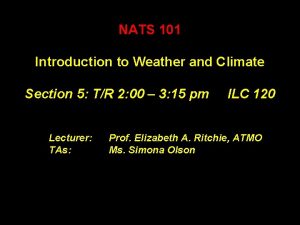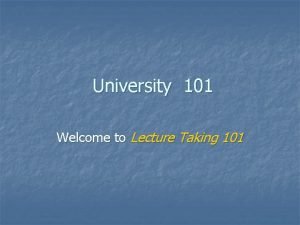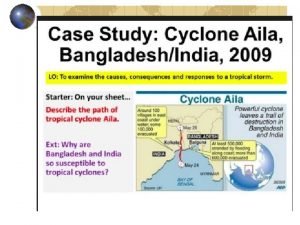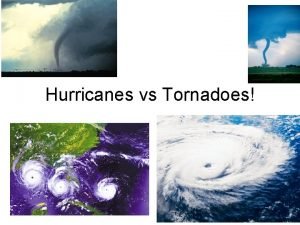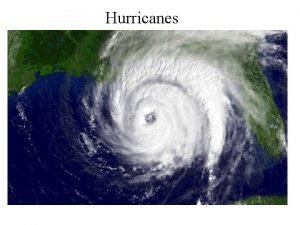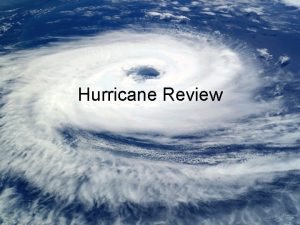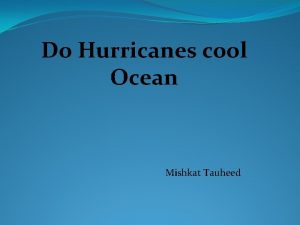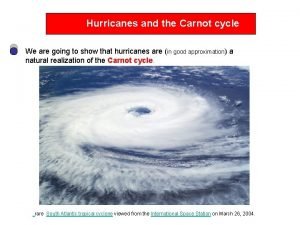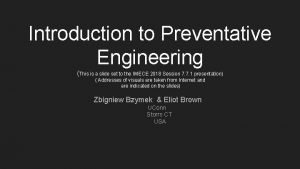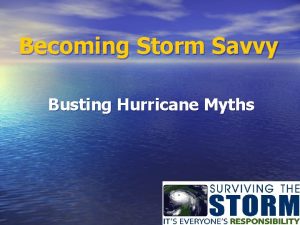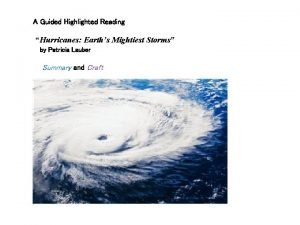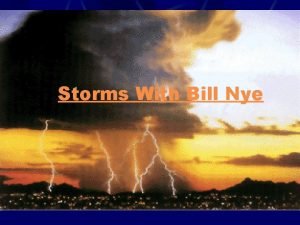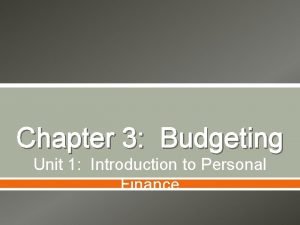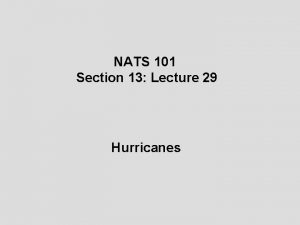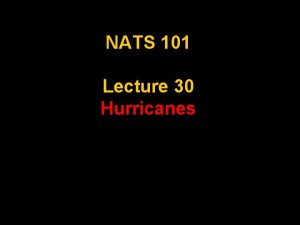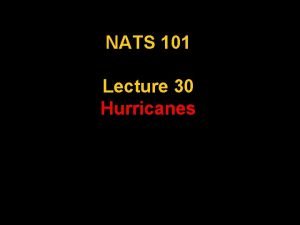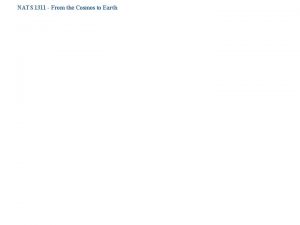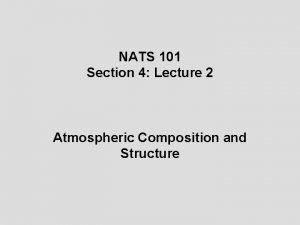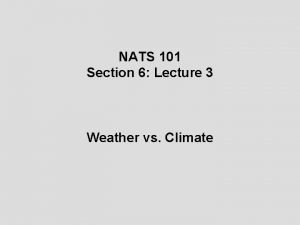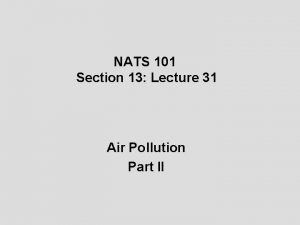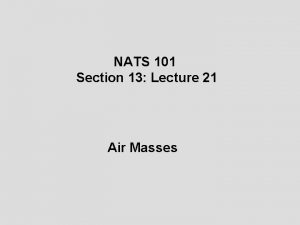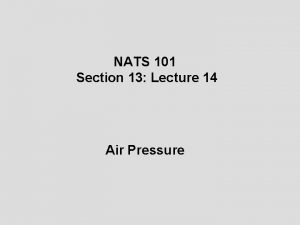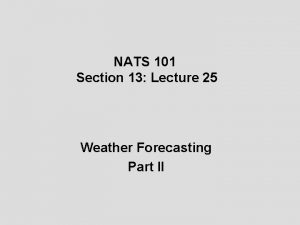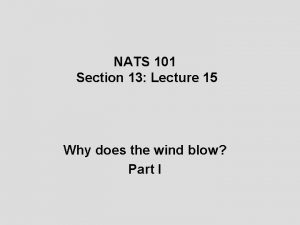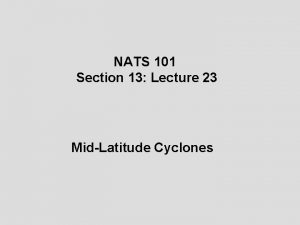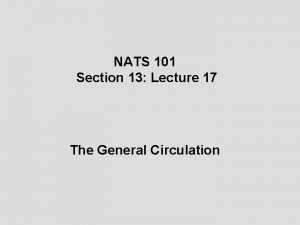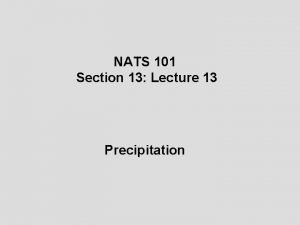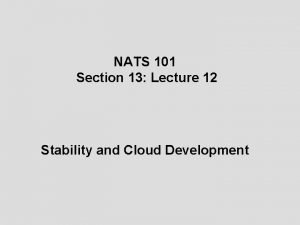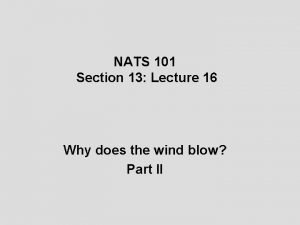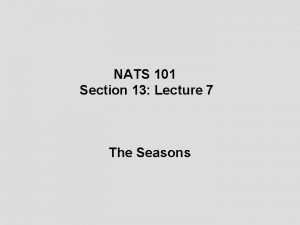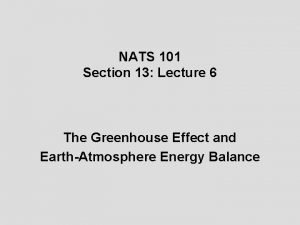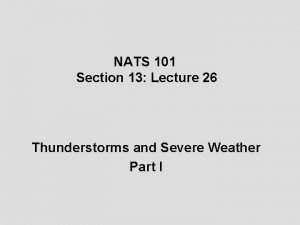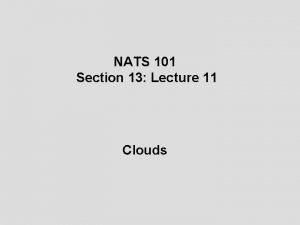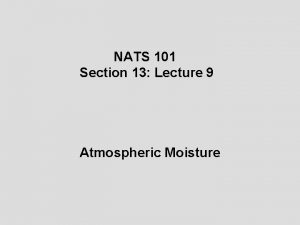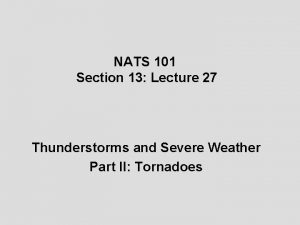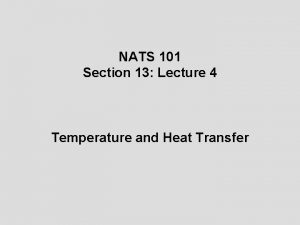NATS 101 Section 13 Lecture 29 Hurricanes Up










































- Slides: 42

NATS 101 Section 13: Lecture 29 Hurricanes

Up to this time, we’ve spent most of the time talking about what goes on the mid-latitudes. Today we shift our attention to the tropics to discuss the most dangerous type of storm—a hurricane.

Why are the tropics different from the mid-latitudes? Virgin Islands There are no big temperature gradients, gentle trade winds. Weather is usually pretty quiescent on a Caribbean island, for example. In the mid 80 s pretty much all year Garden variety thunderstorms due to sea breeze. Some stronger thunderstorms in summer when ITCZ is around

Recall that mid-latitude cyclones derive their energy from the large temperature gradient Because there are virtually no temperature differences in the tropics, a storm in the tropics has to get it’s energy from a different source. WARM MOIST AIR WHICH RELEASES ITS ENERGY BY CONDENSATION IN CLOUDS.

The Atmosphere’s Heat Engine Tropopause Surface LAT EN REL T HEA EAS T E Energy is transferred from a warm region to a cool region, converting some of that energy to do mechanical work—or kinetic energy. COOL REGION WARM REGION (Emmanuel) In the hurricane: Warm region = warm and moist air above ocean’s surface Cool region = cold cloud top (the exhaust) Energy conversion takes place by latent heat release in the cloud.

So what do we need to get the atmospheric engine going? Take the analogy of moving a piston in a car engine, which requires: Fuel = Favorable environmental conditions Spark = A triggering disturbance

Ingredients for a Hurricane Favorable environmental conditions Warm water (>82 °F) through a deep layer Conditionally unstable atmosphere Very moist air through a deep layer Weak vertical wind shear Triggering disturbance Typically a tropical easterly wave, or enhanced area of thunderstorms which propagates westward within the ITCZ.

African Easterly Waves A Trigger for Atlantic Hurricanes Westward Propagation AFRICA Easterly waves Meteosat Enhanced IR Imagery Areas of enhanced thunderstorms propagating westward Thunderstorms originate in west Africa.

If the cluster of thunderstorms within the easterly wave grow to be large enough, they may start to feel the effects of the Earth’s rotation. Then they start to spin about an deepening area of low pressure.

Why does the surface pressure drop? ALOFT High pressure and divergence H LATENT HEAT RELEASE WARMS AND EXPANDS THE COLUMN SURFACE Low pressure and convergence L Once this process gets going, the surface low can continue to deepen and the storm can grow so long as the environmental conditions are right!

Tropical Depression Low pressure system becomes “closed off” and starts to spin about an axis of rotation. Winds: About 20 - 40 miles per hour. Tropical depression which later became Hurricane Rita (2005)

Tropical Storm Winds: 35 – 75 mph Storm gets a name assigned. The names in the Atlantic alternate between male and female names of English, French, or Spanish origin. Tropical Storm Katrina

ONCE THE WINDS EXCEED 75 MPH, THE STORM IS A HURRICANE. Hurricanes are called various other names throughout the world, but it is basically the same type of storm.

Tropical Cyclone Nomenclature NORTHERN HEMISPHERE: Counterclockwise rotation Hurricane: Atlantic and East Pacific Typhoon: North Pacific Cyclone: Northern Indian Ocean (including Bay of Bengal and Arabian Sea) SOUTHERN HEMISPHERE: Clockwise rotation Cyclone: South Pacific and Southern Indian Ocean

Tropical cyclone genesis regions (red) and tracks Observations: Tropical cyclones form in warm tropical waters, starting about 5° latitude AWAY from the equator. Initially move west and curve around subtropical ridges. Hurricanes DO NOT FORM in regions where waters are cold, such as along the west coast of continents where there is upwelling.

Hurricane Intensity given by the Saffir-Simpson Scale Categories range from 1 to 5. MAJOR HURRICANE IS CATEGORY 3 OR ABOVE (We’ll look at some from the 2005 season)

Category 1 Hurricane Winds: 74 -95 mph Pressure: A little more than 980 mb DAMAGE Tree branches, shrubs, and unanchored objects. Hurricane Ophelia

Category 2 Hurricane Winds: 96 -110 mph Pressure: 965 – 979 mb DAMAGE Trees blown down, damage to mobile homes and roofs of buildings. Hurricane Katrina

CATEGORY 3 HURRICANE Winds: 111 -130 mph Pressure: 945 – 964 mb By this point, storm typically has a defined eye in the center. DAMAGE Hurricane Katrina Large trees blown down, mobile homes destroyed, structural damage to buildings.

CATEGORY 4 HURRICANE Winds: 131 -155 mph Pressure: 920 – 944 mb Storm has very well defined eye and a symmetrical shape. DAMAGE Hurricane Rita Extensive damage to infrastructure, severe structural damage to homes and buildings, inland flooding as far as about 5 miles.

Winds: 156 mph and greater CATEGORY 5 HURRICANE Pressure: Below 920 mb As in Category 4, a very symmetrical structure and well defined eye—that is even smaller! Hard to maintain this strength for very long because of the hurricane’s internal dynamics. DAMAGE Hurricane Katrina August 29, 2005 (Figure from Lecture 1) INFRASTRUCTURE SEVERELY DAMAGED. NEARLY TOTAL DEVASATION OF ALL STANDING STRUCTURES. COASTAL ZONES WIPED CLEAN BY HIGH STORM SURGE.

Structure of a Mature Hurricane Well organized rain bands, of increasing severity the closer to the center Most severe band is the EYE WALL, right before the EYE. This is where the strongest winds occur. THE EYE: An area of relative clear, calm winds and sinking air. Sinking air warms due to compression. Where the lowest pressure occurs.

Anticyclonic outflow H L Cyclonic inflow

The Eye from a Hurricane Hunter Flight

Hurricane Tracks: 2005 Each storm has a UNIQUE track that is dependent on the specific weather situation at the time. Track forecasting is actually pretty good up to a few days, but forecasting intensity is still very hard!

So once a hurricane reaches land, what happens? Depends on how strong the storm is and which side of it you’re on.

Asymmetry of hurricane winds: Gulf coast example (Agudo and Burt) West side of storm = WEAK SIDE East side of storm = STRONG SIDE Wind speed is lower because direction is opposite to hurricane movement Wind speed is higher because direction is with hurricane movement.

Causes of hurricane damage at landfall WIND and weak tornadoes (F 1 – F 2) RAIN: Typically 10 inches and higher STORM SURGE: Abnormal rise of sea water at the coastline THE MOST DANGEROUS OF THESE IN A MAJOR HURRICANE IS THE STORM SURGE IS SORT OF LIKE A TSUNAMI, EXCEPT THAT IT IS CAUSED BY THE LOW PRESSURE AND WINDS OF THE HURRICANE—AND NOT AN EARTHQUAKE.

Surge: Hurricane in open ocean Williams, The Weather Book

Surge: Hurricane nearing coastline Williams, The Weather Book

Surge: Hitting coastline Williams, The Weather Book IT WAS WELL KNOWN IN THE METEOROLOGICAL COMMUNITY PRIOR TO KATRINA THAT NEW ORLEANS WAS A MAJOR DISASTER WAITING TO HAPPEN!


Hurricane Demise Once a hurricane makes landfall, it rapidly weakens because: It is cut off from it’s fuel source of warm water. Frictional effects of the land cause the eye to fill in. Tropical Storm Katrina If it goes over colder open water (like the North Atlantic), only the first one of these effects happens. . .

…AND ONE MORE VERY IMPORTANT THING. MAJOR HURRICANES ARE DEADLY. YOU ARE GAMBLING WITH YOUR LIFE IF YOU DON’T GET OUT OF THEIR WAY! LET ME GIVE AN CLASSIC AND TRAGIC EXAMPLE TO DRIVE THIS POINT HOME.

Hurricane Camille: August 1969 Pass Christian, MS This was a Category 5 storm that was VERY MUCH LIKE KATRINA Made landfall on the Mississippi coast, near Pass Christian.

There is a legend that some residents in the Richelieu apartments in Pass Christian decided to ride out the storm and have a “hurricane party” Others say some people sought refuge in the apartments as a last resort because they didn’t evacuate. No one is really sure to this day…

Richelieu Apartments BEFORE CAMILLE AFTER CAMILLE Whether or not the legend is right or not, many of those who were either “partying” or sought refuge did not survive to tell the tale…

Hurricane Ike: September 2008

Galveston, TX: Before Hurricane Ike

Galveston, TX: After Ike

Summary of Lecture 29 The tropics are different from the mid-latitudes because there are no large temperature gradients. A hurricane is essentially a heat engine. To get going need: Favorable environment: SST, instability, low shear Triggering disturbance The triggering disturbance is typically a tropical wave (which originates off west Africa for Atlantic hurricanes). The order of intensity in hurricane development: tropical wave, tropical depression, tropical storm, and hurricane (with categories 1 -5). Hurricanes form in warm tropical water away from the equator and move around subtropical highs. They rapidly weaken once they make landfall. Mature hurricanes have: 1) rain bands, increasing in severity to center; 2) clear and calm eye in the center; 3) cyclonic inflow at surface and anti-cyclonic outflow aloft. The causes of damage at hurricane landfall are wind, rain, and storm surge. The storm surge is the most dangerous.

Review Questions Chapter 15 Questions for Review: 1, 3, 4, 5, 6, 7, 8, 9, 10, 11, 13, 14, 15, 16, 18, 21 (8 th ed. ) 1, 3, 4, 5, 6, 7, 8, 10, 11, 12, 15, 17, 18, 24 (9 th ed. ) Questions for Thought: 1, 2, 4, 7, 8, 9 Problems and Exercises: 1
 Mukhyamantri apprenticeship training scheme
Mukhyamantri apprenticeship training scheme Nats weather
Nats weather 01:640:244 lecture notes - lecture 15: plat, idah, farad
01:640:244 lecture notes - lecture 15: plat, idah, farad What is a harmonic wave in physics
What is a harmonic wave in physics Lecture 101
Lecture 101 Physics 101 lecture 1
Physics 101 lecture 1 Physics 101 lecture notes pdf
Physics 101 lecture notes pdf Notes on waves physics pdf
Notes on waves physics pdf Compare words
Compare words Describe the global distribution of tropical storms
Describe the global distribution of tropical storms How are hurricanes categorized
How are hurricanes categorized Hurricanes vs tornadoes
Hurricanes vs tornadoes Hurricanes definition
Hurricanes definition Scientists have tried to modify hurricanes by ____.
Scientists have tried to modify hurricanes by ____. Bibliography
Bibliography Thermodynamics of hurricanes
Thermodynamics of hurricanes Hurricanes tropical storms
Hurricanes tropical storms Why do hurricanes lose strength over land
Why do hurricanes lose strength over land Hurricanes myths and facts
Hurricanes myths and facts Hurricanes earth's mightiest storms
Hurricanes earth's mightiest storms Compare and contrast signal words
Compare and contrast signal words Bill nye hurricanes
Bill nye hurricanes Quiz cash flow plans do not work when
Quiz cash flow plans do not work when Hidden lines are not generally omitted in a sectional view
Hidden lines are not generally omitted in a sectional view Broken out section
Broken out section Example of half section
Example of half section Section 2 describing energy worksheet answers
Section 2 describing energy worksheet answers Concept mapping chapter 10 meiosis 1 and meiosis 2
Concept mapping chapter 10 meiosis 1 and meiosis 2 Project procurement management lecture notes
Project procurement management lecture notes Lecture about sport
Lecture about sport Healthy lifestyle wrap up lecture
Healthy lifestyle wrap up lecture Meaning of this
Meaning of this Life lecture meaning
Life lecture meaning Randy pausch last lecture summary
Randy pausch last lecture summary Tensorflow lecture
Tensorflow lecture Theology proper lecture notes
Theology proper lecture notes Strategic management lecture
Strategic management lecture Geology lecture series
Geology lecture series Social psychology lecture
Social psychology lecture In text citation for a lecture
In text citation for a lecture Introduction to public sector accounting
Introduction to public sector accounting 4 p's of project management in software engineering
4 p's of project management in software engineering Practical design to eurocode 2 lecture 3
Practical design to eurocode 2 lecture 3

